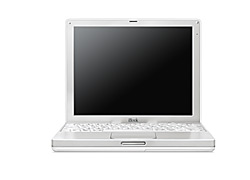
There have been several generations of dual-USB (white) iBooks since their introduction in May, 2001. The following is a table to help you sort out their differences:
(MHz)System Bus
(MHz)
Revision C
January 2002iBook/14"
600
100
256
20
DVD/CDRW
14"
iBook/Combo
600
100
128
20
DVD/CDRW
12"
iBook/CD
500
66
128
15
CD-ROM
12"
Revision B
October 2001iBook/Combo
600
100
128
20
CD-ROM
12"
iBook/CD-RW
600
100
128
20
CD-ROM
12"
iBook/DVD
600
100
128
15
CD-ROM
12"
iBook/CD
500
66
64
10 or 20 (BTO)
CD-ROM
12"
Revision A
May 2001iBook/Combo
500
66
128
10 or 20 (BTO)
DVD/CDRW
12"
iBook/CD-RW
500
66
128
10 or 20 (BTO)
CD-RW
12"
iBook/DVD
500
66
128
10 or 20 (BTO)
DVD-ROM
12"
iBook/CD
500
66
64
10 or 20 (BTO)
CD-ROM
12"
The dual-USB iBooks are good all-around machines, and there is very little to fault. Exceptions include the paltry amount of RAM included on some early CD models, and the slow 66MHz system bus on first-generation units. As opposed to PowerBooks, iBooks do not have a PC card slot, S-video out, or an IR port. On the other hand, they (at least the 12" versions) are much smaller and lighter than the PowerBook G4.